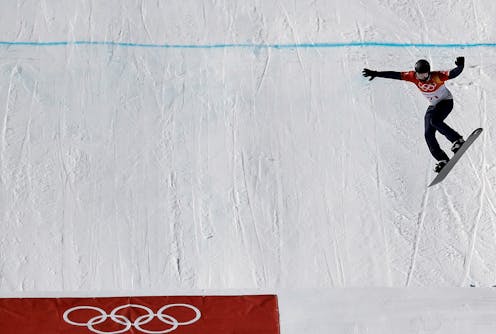The other feats US Olympians pull off
A lack of federal funding for their training, travel or living expenses leaves many elite American athletes juggling day jobs and scrambling to pay their bills.

Millions of Americans watch the Olympics, rooting for members of Team USA. Most of them can probably appreciate how hard those athletes worked on their physical training.
But few realize the lengths these Olympians must go to pay their bills.
Because the U.S. government generally doesn’t help athletes who represent it in the Winter or Summer Games make ends meet, unlike nearly every other country, these Olympians squeeze day jobs into schedules packed with workouts and competitions, seek crowdfunding and scramble for sponsorships.
Keeping their day jobs
For every gold medal-winning champion like snowboarder Chloe Kim, downhill skier Lindsey Vonn, swimmer Michael Phelps and gymnast Simone Biles, there are hundreds of other Olympic athletes who won’t land big endorsement deals.
And since no one gets big bucks for being on the U.S. Olympic team, those lower-profile Olympians must get resourceful.
Personally, I’ve been pretty lucky. While I have never made it to the Olympics, I did try out twice and I competed on the U.S. team at the 2015 Pan American Games. Mizuno, a Japanese sports equipment and sportswear company, is my sponsor. It gives me all the shoes and apparel I need, on top of a modest salary and bonuses tied to my performance. Even so, I have always held part-time or full-time jobs to round out my income.
Currently, I’m working for the University of Oregon – where I get to share with students what I’ve learned firsthand about the business of sports.
I’m hardly alone. Many members of Team USA, most of whom are adults, are holding down day jobs.
Decathlete Jeremy Taiwo, for example, worked part-time at Dick’s Sporting Goods before qualifying for the Rio Games, where he finished in 11th place.
And fencer Ibtihaj Muhammad started her own clothing brand geared toward Muslim women before winning a bronze medal at the Rio Games.

Snowboarder Jonathan Cheever, who competed in Pyeongchang, is a part-time plumber. His teammate Mike Trapp is a mechanic.
Following the money
The most I have earned to date in a single year from running was US$39,000 – not enough to pay my expenses tied to the sport, which can total as much as $20,000 – and the rest of my bills.
But even making that kind of money from athletics is just not possible for most Olympians – especially athletes who excel at less lucrative sports, such as curling or archery.
Instead of getting the financial freedom to dedicate their time and energy to training – like the Olympic stars who land big endorsement deals – they perhaps can land a flexible job at Dick’s Sporting Goods, which runs a special program for Olympians. Or they can receive in-kind support like free equipment from smaller-scale retailers.
They also ask fans to pitch in.
If you search the GoFundMe crowdsourcing website for “Rio Olympics,” you’ll get more than 800 hits for athletes who sought help paying their bills and for their families to travel to the games on their own dime. This extensive crowdfunding, however, began long before digital platforms made it easy to connect athletes with patrons large and small.
A big business
Although most U.S. athletes must get resourceful to cover their bills, the Olympics are a big business that generates billions of dollars in revenue a year. The International Olympic Committee distributes the bulk of this money to national committees operating in every country that competes, which then choose how to spend those dollars.
The U.S. Olympic Committee, an independent nonprofit, drew a total of $920 million between the 2012 Winter Games in Sochi and the 2016 Summer Games in Rio de Janeiro. But it has many expenses on top of paying athletes. That means it can’t distribute all of this money to the many American governing bodies responsible for different sports.
In 2016, for instance, the U.S. Olympic Committee handed out $84.7 million in grants. It parceled out more to the governing bodies for the sports that had been winning the most medals, including those overseeing skiing and snowboarding, track and field, and swimming, than the rest.
These organizations give both current Olympians and potentially Olympic-bound athletes stipends that help cover the cost of training. As the system works today, there simply isn’t enough of this money to go around.
Sparse financial rewards
In the U.S., most of these stipends are meager, sometimes amounting to only $1,000 per month, below the official poverty line.
The U.S. athletes who win medals also collect cash prizes: $37,500 for gold, $22,500 for silver and $15,000 for bronze. This windfall, in reality, is just enough for a down payment on next year’s expenses.
There are very few options for most athletes no matter how entrepreneurial or victorious they are. Male and female figure skaters can spend a few years making a living by performing on Disney on Ice tours, and male hockey and basketball players who compete at the Olympics can keep playing on professional teams. But there are virtually no gigs for bobsledders.
So the next time you watch your country’s Olympic contenders compete, remember that these elite athletes probably had to overcome financial hardships before they could represent the U.S. at the games.
Craig Leon has an athlete endorsement contract with Mizuno, a Japanese company that makes sports equipment and gear.
Read These Next
From concrete to community: How synthetic data can make urban digital twins more humane
Urban digital twins pull together tremendous amounts of data to realistically model cities, but they’ve…
When darkness shines: How dark stars could illuminate the early universe
Some unique ‘stars’ might be fueled by dark matter annihilation.
Sea level doesn’t rise at the same rate everywhere – we mapped where Antarctica’s ice melt would hav
Understanding what happens to Antarctica’s ice matters, because as it melts, sea levels rise, affecting…






